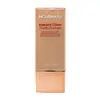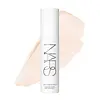What's inside
What's inside
 Key Ingredients
Key Ingredients

 Benefits
Benefits

 Concerns
Concerns

 Ingredients Side-by-side
Ingredients Side-by-side

Water
Skin ConditioningCyclopentasiloxane
EmollientDimethicone
EmollientButylene Glycol
HumectantGlycerin
HumectantSilica
AbrasiveSynthetic Fluorphlogopite
Polysilicone-11
PEG-10 Dimethicone
Skin ConditioningPolysorbate 60
EmulsifyingIsononyl Isononanoate
EmollientHydroxyethyl Acrylate/Sodium Acryloyldimethyl Taurate Copolymer
Emulsion StabilisingIsohexadecane
EmollientPhenoxyethanol
PreservativeSqualane
EmollientSorbitan Stearate
EmulsifyingCarbomer
Emulsion StabilisingMica
Cosmetic ColorantTocopheryl Acetate
AntioxidantEthylhexylglycerin
Skin ConditioningSodium Hyaluronate
HumectantSucrose Cocoate
EmulsifyingSorbitan Isostearate
EmulsifyingDisodium EDTA
Titanium Dioxide
Cosmetic ColorantCI 77499
Cosmetic ColorantCI 77491
Cosmetic ColorantTin Oxide
AbrasiveWater, Cyclopentasiloxane, Dimethicone, Butylene Glycol, Glycerin, Silica, Synthetic Fluorphlogopite, Polysilicone-11, PEG-10 Dimethicone, Polysorbate 60, Isononyl Isononanoate, Hydroxyethyl Acrylate/Sodium Acryloyldimethyl Taurate Copolymer, Isohexadecane, Phenoxyethanol, Squalane, Sorbitan Stearate, Carbomer, Mica, Tocopheryl Acetate, Ethylhexylglycerin, Sodium Hyaluronate, Sucrose Cocoate, Sorbitan Isostearate, Disodium EDTA, Titanium Dioxide, CI 77499, CI 77491, Tin Oxide
Water
Skin ConditioningPropanediol
SolventGlycerin
HumectantSqualane
EmollientIsodecyl Neopentanoate
EmollientC9-12 Alkane
SolventPolyurethane-35
Mica
Cosmetic ColorantTrehalose
HumectantChondrus Crispus Extract
Skin ConditioningCamellia Japonica Flower Extract
EmollientTheobroma Cacao Seed Extract
AntioxidantMoringa Oleifera Seed Extract
Skin ConditioningSodium Hyaluronate
HumectantGluconolactone
Skin ConditioningMethylpropanediol
SolventCaprylyl Glycol
EmollientPhenylpropanol
MaskingHydrogenated Lecithin
EmulsifyingCoco-Caprylate/Caprate
EmollientSodium Carrageenan
Emulsion StabilisingSea Salt
AbrasivePhytosteryl/Octyldodecyl Lauroyl Glutamate
Skin ConditioningTocopherol
AntioxidantMangifera Indica Seed Butter
Skin ConditioningOrbignya Oleifera Seed Oil
EmollientPhospholipids
Skin ConditioningTocopheryl Acetate
AntioxidantHydroxyethyl Acrylate/Sodium Acryloyldimethyl Taurate Copolymer
Emulsion StabilisingPolysorbate 60
EmulsifyingSorbitan Isostearate
EmulsifyingAmmonium Acryloyldimethyltaurate/Vp Copolymer
Sodium PCA
HumectantSodium Acrylates Crosspolymer-2
AbsorbentHydrolyzed Hyaluronic Acid
HumectantXanthan Gum
EmulsifyingLecithin
EmollientSclerotium Gum
Emulsion StabilisingPullulan
Silica
AbrasiveSynthetic Fluorphlogopite
Trisodium EDTA
Sodium Citrate
BufferingCitric Acid
BufferingButylene Glycol
HumectantPentylene Glycol
Skin ConditioningDisodium Phosphate
BufferingPhenoxyethanol
PreservativeSodium Benzoate
MaskingBenzyl Alcohol
PerfumingCI 77491
Cosmetic ColorantCI 14700
Cosmetic ColorantCI 77891
Cosmetic ColorantCI 19140
Cosmetic ColorantWater, Propanediol, Glycerin, Squalane, Isodecyl Neopentanoate, C9-12 Alkane, Polyurethane-35, Mica, Trehalose, Chondrus Crispus Extract, Camellia Japonica Flower Extract, Theobroma Cacao Seed Extract, Moringa Oleifera Seed Extract, Sodium Hyaluronate, Gluconolactone, Methylpropanediol, Caprylyl Glycol, Phenylpropanol, Hydrogenated Lecithin, Coco-Caprylate/Caprate, Sodium Carrageenan, Sea Salt, Phytosteryl/Octyldodecyl Lauroyl Glutamate, Tocopherol, Mangifera Indica Seed Butter, Orbignya Oleifera Seed Oil, Phospholipids, Tocopheryl Acetate, Hydroxyethyl Acrylate/Sodium Acryloyldimethyl Taurate Copolymer, Polysorbate 60, Sorbitan Isostearate, Ammonium Acryloyldimethyltaurate/Vp Copolymer, Sodium PCA, Sodium Acrylates Crosspolymer-2, Hydrolyzed Hyaluronic Acid, Xanthan Gum, Lecithin, Sclerotium Gum, Pullulan, Silica, Synthetic Fluorphlogopite, Trisodium EDTA, Sodium Citrate, Citric Acid, Butylene Glycol, Pentylene Glycol, Disodium Phosphate, Phenoxyethanol, Sodium Benzoate, Benzyl Alcohol, CI 77491, CI 14700, CI 77891, CI 19140
Ingredients Explained
These ingredients are found in both products.
Ingredients higher up in an ingredient list are typically present in a larger amount.
Butylene Glycol (or BG) is used within cosmetic products for a few different reasons:
Overall, Butylene Glycol is a safe and well-rounded ingredient that works well with other ingredients.
Though this ingredient works well with most skin types, some people with sensitive skin may experience a reaction such as allergic rashes, closed comedones, or itchiness.
Learn more about Butylene GlycolCi 77491 is also hydrated iron III oxide. It's sole purpose is to give a red/pink hue to products.
Iron III oxides are classified as inorganic chemicals for coloring.
Synthetically created Ci 77491 is considered safer than those naturally found. This is because the synthetically created version may contain less impurities. Iron oxides are generally non-toxic and non-allergenic.
Learn more about CI 77491Glycerin is already naturally found in your skin. It helps moisturize and protect your skin.
A study from 2016 found glycerin to be more effective as a humectant than AHAs and hyaluronic acid.
As a humectant, it helps the skin stay hydrated by pulling moisture to your skin. The low molecular weight of glycerin allows it to pull moisture into the deeper layers of your skin.
Hydrated skin improves your skin barrier; Your skin barrier helps protect against irritants and bacteria.
Glycerin has also been found to have antimicrobial and antiviral properties. Due to these properties, glycerin is often used in wound and burn treatments.
In cosmetics, glycerin is usually derived from plants such as soybean or palm. However, it can also be sourced from animals, such as tallow or animal fat.
This ingredient is organic, colorless, odorless, and non-toxic.
Glycerin is the name for this ingredient in American English. British English uses Glycerol/Glycerine.
Learn more about GlycerinThis is a synthetic polymer. It helps improve the texture of products by adding thickness and gel-like feel.
It is also an emulsifer, meaning it prevents ingredients such as oil and water from separating. It also helps evenly disperse other ingredients.
Mica is a naturally occurring mineral used to add shimmer and color in cosmetics. It can also help improve the texture of a product or give it an opaque, white/silver color.
Serecite is the name for very fine but ragged grains of mica.
This ingredient is often coated with metal oxides like titanium dioxide. Trace amounts of heavy metals may be found in mica, but these metals are not harmful in our personal products.
Mica has been used since prehistoric times throughout the world. Ancient Egyptian, Indian, Greek, Roman, Aztec, and Chinese civilizations have used mica.
Learn more about MicaPhenoxyethanol is a preservative that has germicide, antimicrobial, and aromatic properties. Studies show that phenoxyethanol can prevent microbial growth. By itself, it has a scent that is similar to that of a rose.
It's often used in formulations along with Caprylyl Glycol to preserve the shelf life of products.
Polysorbate 60 is used to help stabilize products. It is a surfactant and emulsifier. These properties help keep ingredients together in a product. Surfactants help reduce surface tension between ingredients with different states, such as liquids and solids. Emulsifiers help prevent oils and waters from separating.
Polysorbate 60 is sorbitol-based and created from the ethoxylation of sorbitan. Ethoxylation is a chemical reaction used to add ethylene oxide. Sorbitan is a the dehydrated version of sorbitol, a sugar found in fruits.
In this case, the 60 comes from reacting 60 units of ethylene oxide with sorbitan.
Polysorbates are commonly used in medicine and foods.
Learn more about Polysorbate 60Silica, also known as silicon dioxide, is a naturally occurring mineral. It is used as a fine, spherical, and porous powder in cosmetics.
Though it has exfoliant properties, the function of silica varies depending on the product.
The unique structure of silica enhances the spreadability and adds smoothness, making it a great texture enhancer.
It is also used as an active carrier, emulsifier, and mattifier due to its ability to absorb excess oil.
In some products, tiny microneedles called spicules are made from silica or hydrolyzed sponge. When you rub them in, they lightly polish away dead skin layers and enhance the penetration of active ingredients.
Learn more about SilicaSodium Hyaluronate is hyaluronic acid's salt form. It is commonly derived from the sodium salt of hyaluronic acid.
Like hyaluronic acid, it is great at holding water and acts as a humectant. This makes it a great skin hydrating ingredient.
Sodium Hyaluronate is naturally occurring in our bodies and is mostly found in eye fluid and joints.
These are some other common types of Hyaluronic Acid:
Learn more about Sodium HyaluronateSorbitan Isostearate is an emulsifer and cleaning agent. It is created from isostearic acid and sorbitol.
As an emulsifier, Sorbitan Isostearate prevents oils and water from separating.
Due to its isostearic acid base, it may not be safe for Malassezia or fungal acne.
Learn more about Sorbitan IsostearateSqualane is an emollient that helps the skin hold onto moisture. It's an oily liquid that occurs naturally in certain types of fish and plant oils.
Because squalane boosts hydration in the skin, it also comes with plenty of benefits: it is an antioxidant and can help fight free radicals and skin damage. Squalane is also found to have a detoxifying effect when applied.
Squalane comes from squalene, which occurs naturally within the sebum of our skin. It is one of the oils our skin produces to keep itself hydrated. Squalane is the hydrogenated version of squalene and has a longer shelf life.
Research shows that squalane is non-irritating (even at 100% concentration).
In general, it's a fantastic ingredient. It does a great job at hydrating the skin, and it's suitable for those with sensitive skin.
The source of squalane may impact malassezia / fungal acne. This is because olive oil derived squalane can contain impurities such as fatty acids and plant waxes. Sugarcane derived squalane is recommended for anyone with malassezia concerns.
Is squalane vegan?
This depends on the source. Squalane can be derived from both plants and animals. Most squalane used in skincare comes from plants.
Please note: the source of squalane is only known if disclosed by the brand. We recommend reaching out to the brand if you have any questions about their squalane.
Read more about squalene with an "e".
Is squalane an oil?
Squalane is often called an oil, but it’s technically not; it’s a hydrocarbon, meaning it’s only made of carbon and hydrogen, unlike true oils which are triglycerides made of fatty acids and glycerol.
The term “oil-free” isn’t regulated, so companies can define it however they want. Some exclude all oils, while others just avoid mineral oil or comedogenic oils.
While some people avoid oils thinking they cause breakouts, the right kind of oil (or oil-like ingredient like squalane) can actually help balance and hydrate your skin. It’s worth testing out simple oils or squalane to see what works best for your skin.
Learn more about SqualaneSynthetic Fluorphlogopite is the synthethic version of mica. It consists of fluorine, aluminum and silicate.
Synthetic Fluorphlogopite is used to add volume to products.
It is considered non-irritating on the skin.
Learn more about Synthetic FluorphlogopiteTocopheryl Acetate is AKA Vitamin E. It is an antioxidant and protects your skin from free radicals. Free radicals damage the skin by breaking down collagen.
One study found using Tocopheryl Acetate with Vitamin C decreased the number of sunburned cells.
Tocopheryl Acetate is commonly found in both skincare and dietary supplements.
Learn more about Tocopheryl AcetateWater. It's the most common cosmetic ingredient of all. You'll usually see it at the top of ingredient lists, meaning that it makes up the largest part of the product.
So why is it so popular? Water most often acts as a solvent - this means that it helps dissolve other ingredients into the formulation.
You'll also recognize water as that liquid we all need to stay alive. If you see this, drink a glass of water. Stay hydrated!
Learn more about Water